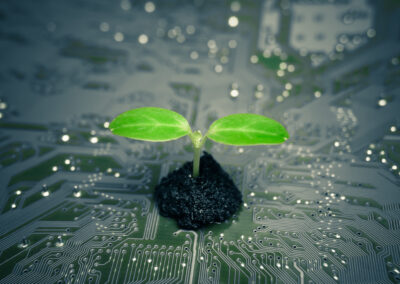Precision Agriculture: Leveraging digital tools to respond to a dual imperative
by GIGAEurope
Brussels – 23 November 2022 – COP27 concluded in Sharm El-Sheikh, after two weeks of global leaders affirming commitments to reduce greenhouse gas emissions and curb environmental degradation. EU leaders maintained their resoluteness to implement the European Green Deal and accelerate the continent’s transition to becoming climate neutral by 2050.
The European Commission’s ‘Farm to Fork’ strategy is an essential component of the European Green Deal. As primary producers, farms and farming communities are at the core of this strategy, which aims to reduce the impact of the agricultural sector on the environment and build sustainable food systems.
Intertwined with political will, and growing consumer demand to minimise the impact of food production on the environment, is farmers’ fundamental need to ensure the longevity and sustainability of their livelihoods. A Vodafone commissioned survey report by Savanta ComRes found that, on average, over 95% of farmers surveyed in 13 European countries stated that they would like to increase the sustainability of their farms.
Process to reduce the sector’s impact on the environment is already under way
Currently, the agriculture sector benefits from a variety of technology-based solutions. A 2020 McKinsey survey report found that around 50% of dairy farmers in Europe use software to track and optimise the health of animals. Communities of farmers across Europe are also making their existing practices more precise, thereby minimising the use of chemical pesticides. A European Commission 2022 impact assessment reported that farmers in a region in Spain reduced use of chemical pesticides by around 55% in vegetable production. Similarly, tests conducted by Sunrise UPC, an affiliate of Liberty Global, showed that drones connected with 5G data connections helped reduce pesticides usages of up to 90% in weed removal.
Many operators of farms benefit from other precision farming techniques such as metered sprayers and sensors that help to reduce the use of pesticides and conserve water. Agronomic data and drone imagery monitor crop health and soil quality to ensure efficient use of costly agricultural inputs and optimise harvests. Tracking systems monitor temperature and help maintain ideal conditions for fruits and vegetables throughout the journey to retailers. This helps to ensure that produce arrives at its final destination in good condition and minimises food waste. It also offers the traceability that consumers are increasingly demanding.
Other digital solutions leverage big data to conduct simulations. The data from these simulations can assist farmers with making more informed decisions and mitigate the effects of climate shocks and climatic variations. Cloud-based technologies can help new adapters benefit from AKIS (Agriculture Knowledge and Innovation Systems) and peer-to-peer learning. These benefits can be essential, even at the nascent stages when farmers are in the process of determining which tools and what level of investment is right for them.
In the EU 2020 Code of Conduct on Agricultural Data Sharing, the European Commission characterises digital farming as an “unprecedented opportunity… to improve resource efficiency, productivity, environmental processes, animal health and welfare, and provide tools to mitigate climate change…” Furthermore, the Commission’s ‘Farm to Fork’ strategy highlights the importance of technology uptake among farmers and farming communities in achieving the objectives of the European Green Deal.
Tackling barriers to broader adoption of digital technologies in agriculture
There are, however, some key barriers to the adoption of digital technologies within the agricultural industry that need to be addressed as a matter of urgency. There is still more to understand around the needs of small farms and the type of cost-benefit analyses required to engender trust and encourage adoption of evolving tools and new technologies.
In the 2017 report from the Connecting World Farmers to the Value Chain workshop, Copa Cogeca (representatives of European farmers and agri-cooperatives) cite additional impediments such as the lack of digital education and poor awareness of emerging technologies for the sector. The report also lists digital infrastructure as a concern. Farmers can only benefit from digital tools if there is secure and reliable high-speed connectivity available in their community.
A new generation of farmers is entering the sector. While demographic change may present an opportunity for more widespread adoption, it is unclear if digital technologies will be widely understood by all actors in the sector. In addition to the provision of digital education, there is a need to ensure that the skills are relevant and deemed a worthy investment of time, a scarce resource for farmers. Furthermore, sound data governance and management practices are key to addressing farmers’ concerns around ownership and privacy of the large amounts of data collected via precision farming technologies and, ultimately, to building trust in these tools going forward.
As agricultural standards evolve, questions remain around what an enabling policy framework consists of and what role Gigabit connectivity will play in the deployment of technology-based solutions. On 5 December, representatives from farming communities, EU Institutions, and industry will addressed these pressing questions during the next EURACTIV-GIGAEurope Digital Debate Series event.
🖱️As precision farming techniques expand across Europe🇪🇺, cloud-based platforms help farming communities access comprehensive databases, with a single dashboard, for peer-to-peer learning. #IoT #Digital pic.twitter.com/gJoitMH2W9
— GIGAEurope (@GigaEurope) December 6, 2022
Have a look at this Twitter moment from yesterday's event "Precision Agriculture - What do EU farmers want?".
— EURACTIV Agri & Food (@eaAgriFood) December 6, 2022
You can also find a recording of the event here : https://t.co/yB8d3N8DA5https://t.co/oHdEcERncv
RELATED ARTICLES

Do We Have All the Right Networks for the Future?

Be Courageous, Confident, & Curious: Insights for Women in ICT

On the Digital Highway – Destination: a Competitive Europe

EU Connectivity Needs Fast Rollout – Policies Must Aid Objectives

Interconnecting the Connectivity Talks

The EU made the case for digital – now skills must follow

Enabling the Enablers: A Path to Europe’s Green Transition

How to ensure no European is left behind?

How connectivity can help bridge the digital trust gap

Capturing Europe’s Connectivity Momentum

